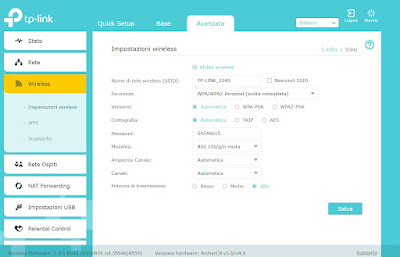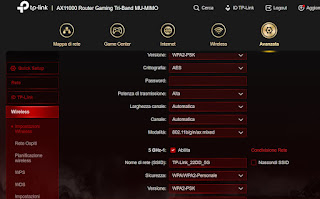Guide to configuring a wifi modem router to secure it and prevent unauthorized access to the internet from the outside.
 Modern modems have become extremely easy to set up and are often “ready to use” as soon as we connect them to the network.
Modern modems have become extremely easy to set up and are often “ready to use” as soon as we connect them to the network.If we wanted to have more control and greater security on wireless connections we will necessarily have to enter the settings of the modem (or router if we have an additional device connected to the modem) and change some items, so as to be able to browse peacefully within the home and avoid intruders.
In this guide, we will show you how to properly configure the router to create a secure and fast Wi-Fi network so you can connect any type of device using the wireless network made available.
For ease of understanding, we will show you all the steps to follow as if we had just plugged in the modem; the guide is valid both for modems supplied by telephone operators and for third-party modems/routers purchased in electronics stores or on e-commerce sites.
READ ALSO -> Best WiFi routers to connect wireless home devices
1) Log in to the control panel
After connecting the modem with all cables and having accessed it, we will have to immediately access the control panel to see if the Internet connection is configured correctly and to access the Wi-Fi settings.
For this step, we always recommend using a laptop connected via Ethernet to the new router, so that you can configure everything without having to connect to the default Wi-Fi network offered by the device (often supplied without an access password and with a strange name).
Once a notebook is connected via Ethernet cable, we access the operating system, open any browser (Chrome or Edge is fine too), and type one of the access IP addresses in the address bar (top):
- 192.168.1.1
- 192.168.0.1
- 192.168.1.254
If we are unable to log in with one of these addresses, we recommend that you check the user manual of the router to identify the IP address of access or use the Windows command prompt to discover the IP address of the Gateway.
The username and password to access the administration panel of the modem under the modem case or in the user manual. Usually, the username and password are admin–admin but if it doesn’t work we can consult the list of the default login and password per modem.
Some routers also let you choose your personal password at the first start, so as to be able to generate a more secure one instead of the simple “admin”: we choose a password that is long enough but that we can remember easily (since for to reset it requires a total reset of the modem with loss of all customizations).
After entering the correct credentials, the welcome screen of the router configuration panel will welcome us.
2) Configure Internet connection
If our modem is not provided by the operator, we will have to manually configure the Internet connection parameters, so you can navigate. In the modem configuration panel, we click on Quick Setupso you can start the Internet setup wizard (very easy to apply).
Once the right screen is opened, we configure the initial settings (such as for example Village e Time zone) and choose, when requested, the telephone operator we are using for our landline.
We confirm all subsequent steps by clicking on Avanti, running a quick connection test, and finally, clicking Finish to finish the setup. These steps should work in 90% of cases without any problem: if the line is still absent, let’s try to open any browser to verify that the connection is present and that an additional step is not necessary such as entering the ADSL credentials or the tax code (depends on the operator in use).
If our modem is connected via Ethernet cable and with the WAN port, the connection will be automatic without having to configure anything: in this case, the Internet is managed by the modem supplied by the operator or by the ONT converter for optical fiber present as a wall socket.
To learn more we can read our guides on how to configure the modem for TIM, Fastweb, Vodafone, and Wind and how to carry out configuration for ONT and fiber optic connection parameters.
3) Create a secure Wi-Fi network
Now that the Internet connection is active, we need to configure the Wi-Fi networks in order to offer the right degree of security and speed to wireless connections.
Let’s go back to the modem configuration panel and identify the menu Wireless, WLAN o Wi-Fi; if necessary let’s also going to the section Advanced or activate the Expert mode or one Advanced mode so as to have all the options of the device available.
On modern modems we have to configure two wireless networks: the 2.4 GHz network and the 5 GHz network; usually, there is a selector at the top right or two separate tabs to configure the two networks, otherwise, a single menu may be available for the combined configuration (which we always recommend deactivating for more control).
To understand what we are referring to when we talk about the two networks, we can read our guide on the differences between 2.4 GHz and 5 GHz Wi-Fi networks.
Rete a 2,4 GHz
As a first step let’s configure the 2.4 GHz Wi-Fi network: let’s choose one strong enough password (at least 10 characters with capital letters and special symbols @, &, $,%, etc.), and we set a name of your choice for the network (SSID), we choose as version WPA2-PSK o WPA3we choose the strongest encryption available (usually AES), we choose the mixed network as mode (802.11b/g/n or Wi-Fi 3/4/5), we choose how to channel the one with the most minor interference and finally, we choose as bandwidth 20 MHz.
If the modem allows you to adjust the transmission power, make sure to always set it to maximum if we have a house larger than 60 square meters, otherwise, we use lower powers to limit the extension outside the walls of the house (Average Power o Low).
Rete a 5 GHz
Now we also configure the 5 GHz network: we open the appropriate menu, let’s set a secure password (which can also be identical to that used for 2.4 GHz), we set a network name identical to the one used before but with the suffix 5G, we put WPA2-PSK o WPA3 as a version, we use AES as an encryption system, we set the proper network mixed mode (802.11 n/a o Wi-Fi 4/5) and leave all the other points unchanged.
Compared to 2.4GHz networks, we can leave the management of channels and bandwidth to the modem, since the 5 GHz network is much less prone to interference. Once the configuration is complete, click on Salva about are OK at the bottom and restart the modem as a precaution, so as to have immediately all the active settings.
4) Activate Wi-Fi 6
On modern modems, it is also possible to activate the Wi-Fi 6 network, which combines the characteristics of the two networks seen above and offers very high connection speeds, as seen in our guide to Wi-Fi modems 6.
Usually, the Wi-Fi 6 network can be activated as a “mixed network”, so that it can be used if necessary only when we connect compatible devices. For maximum compatibility, it is, therefore, advisable to activate 802.11a/n/ac/ax mixed, 802.11b/g/n/ax mixed, or similar rumors, on both 2.4GHz and 5GHz networks.
5) Other wireless features
Now that the wireless networks are ready too, let’s use the configuration panel to configure (where possible) other settings to increase the security of Wi-Fi connections:
- disable WPS: the WPS function is convenient to be able to connect devices without having to enter the password, but it can be used by hackers to connect without permission to our modem; if the latter allows, it is better to completely disable the functionality;
- activate the Guest Network: we can create another Wi-Fi network to be reserved for guests who arrive at home, so that they can be connected in a separate network from private devices;
- block Mac addresses: to increase security we can also apply a MAC Address filter to connect only authorized devices;
- Activate invisible network name: from modern modems we can also disable sending of the network name (i.e. the SSID) which therefore allows you not to show your network outside (only those who know the network name can enter it manually to connect).
These options are highly restrictive making your home network very secure and almost impossible to hack.
Conclusions
By following to the letter all the advice in this guide we will be able to set up a new, very secure Wi-Fi network adopting the right countermeasures to be able to access in total safety and prevent some “Sunday hackers” from accessing the system without our permission.
If we are afraid that someone has already joined our network, we suggest you read the guides on how to check who steals your WiFi internet connection and how to see the IPs connected to the Wi-Fi network from Android or iPhone.
In another guide, we have shown you the Main options on the Wifi modem: access and configuration via the web that we can use to improve the browsing experience.
In another article, we told you about free programs for network diagnostics and problem-solving and how manually troubleshoot a home network configuration error.


